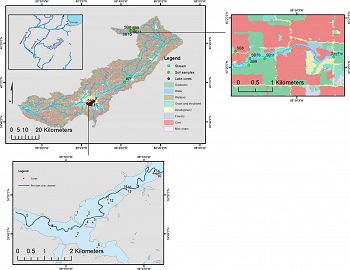Blair et al., 2018
The C-biogeochemistry of a Midwestern USA agricultural impoundment in context: Lake Decatur in the intensively managed landscape critical zone observatory
Blair, N.E., Leithold, E.L., Papanicolaou, A.N., Wilson, C.G., Keefer, L., Kirton, E., Vinson, D., Schnoebelen, D., Rhoads, B., Yu, M., and Lewis, Q. (2018)
Biogeochemistry
-
IML, INVESTIGATOR
-
IML, INVESTIGATOR
-
IML, INVESTIGATOR
-
IML, INVESTIGATOR
-
IML, INVESTIGATOR
-
IML, INVESTIGATOR
-
IML, GRAD STUDENT
Abstract
Maps of Lake Decatur and the Upper Sangamon watershed. Land use is color coded. Sample locations are shown as green circles for soils and red circles for lake sediments. The line in the center of the lake traces the original river channel prior to dam emplacement (adapted from Fig. 2 in Fitzpatrick et al. 1987). (Color figure online)
The damming of rivers has created hotspots for organic carbon sequestration and methane production on a global scale as the reservoirs intercept fluvial suspended and dissolved loads. To better understand how the C-biogeochemistry of a reservoir responds to watershed processes and evolves over time, Lake Decatur, located in the Intensively Managed Landscape Critical Zone Observatory (IML-CZO) was studied. Solid phase analyses (% organic C, C/N, d13C, d15N) of soils and sediments sampled from stream bank exposures, river suspensions, and the lake bottom were conducted to characterize organic C (OC) sources throughout the sedimentary system. Agriculturally driven soil erosion rapidly altered lake bathymetry causing an evolution of sedimentary and OC deposition patterns, which in turn shaped where and when methane production occurred. A positive correlation between OC accumulation rate and porewater dissolved inorganic C (DIC) d13C profiles indicates that methane generation is strongly influenced by OC burial rate. The sources of the lake bed particulate organic C (POC) have also evolved over time. Drowned vegetation and/or shoreline inputs were dominant initially in areas adjacent to the original river channel but were rapidly overwhelmed by the deposition of sediments derived from eroded agricultural soils. Eutrophication of the lake followed with the onset of heavy fertilizer application post-1960. This succession of sources is expected to be commonplace for reservoirs greater than * 50–60 years old in agricultural settings because of the relative timing of tillage and fertilizer practices. The 13C/12C ratios of methane from Lake Decatur were more depleted in 13C than what is commonly expected for freshwater sedimentary environments. The 13C-depletion suggests that CO2-reduction is the dominant methanogenic pathway rather than the anticipated acetate dissimilation process. The isotopic observations reveal that commonly held assumptions about methane production and its C-isotopic signature in freshwater systems are over-simplified and not strictly applicable to this system.
Citation
Blair, N.E., Leithold, E.L., Papanicolaou, A.N., Wilson, C.G., Keefer, L., Kirton, E., Vinson, D., Schnoebelen, D., Rhoads, B., Yu, M., and Lewis, Q. (2018): The C-biogeochemistry of a Midwestern USA agricultural impoundment in context: Lake Decatur in the intensively managed landscape critical zone observatory. Biogeochemistry. DOI: 10.1007/s10533-018-0439-9
 This Paper/Book acknowledges NSF CZO grant support.
This Paper/Book acknowledges NSF CZO grant support.
Explore Further








